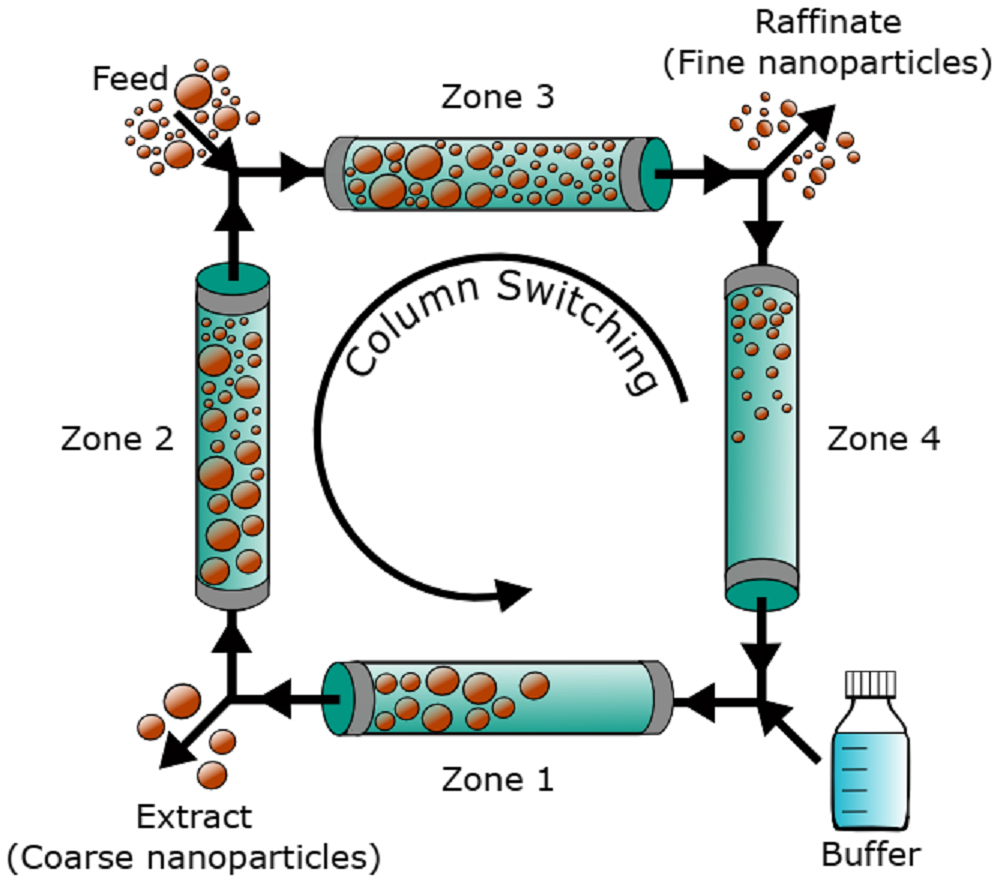Magnetic nanoparticles (MNPs) are becoming increasingly important in many medical and technical disciplines. In the medical field, these include, for example, gene therapy [
1] or cancer treatment by targeted drug delivery and magnetic hyperthermia, since the use of spatially focused magnetic fields in combination with functionalized MNPs allows to provide unique specificity to certain therapies [
2–
6]. Furthermore, a promising application as a contrast agent in MRI diagnoses is apparent [
7–
9]. On the technical side, MNPs are increasingly used for sensing [
10], magnetic bearings [
11], waste water treatment [
12,
13] and separation techniques [
14]. An important quality parameter for MNPs is the uniformity of their particle size [
15,
16]. Even if a nominal particle size of the MNPs can be described after the synthesis, there is usually a more or less broad size distribution due to process-related reasons [
17–
19]. Besides optimizing particle synthesis, the quality of the MNP product line can be improved by subsequent fractionation. However, in the size range of about 20–200 nm fractionation processes encounter technical difficulties, which so far have only been solved to a limited extent. This problem is also apparent, for example, in high efficiency particulate air filters, where this size range is known as “most penetrating particle size” [
20–
22]. The reason for this separation gap is that there is a complex overlapping of forces in this size range. For example, volume forces are particularly important [
23] for fractionation processes from the micrometer range onwards, while Brownian motion, diffusion and convection play a major role in the sub-nanometer scale [
24]. For these reasons, the high-resolution size fractionation of MNPs continues to be an intensively studied scientific field. In this context, size separation means a selective fractionation of particles with a broad size distribution into two or more fractions, which differ in their mean particle diameter. So far, various processes have been investigated for this purpose, including micro- and ultrafiltration [
25,
26], acoustic fractionation [
23,
27], gel electrophoresis [
28] and ultracentrifugation [
29,
30]. An established separation process for MNPs is the use of so-called high gradient magnetic separators [
31,
32]. However, the strong magnetic fields and field gradients used in these apparatus result in a practically complete separation of all magnetic particles in the feed stream. Therefore, these separators only have very limited efficiencies when being considered for size fractionations. Other separation processes such as field flow fractionation can achieve reproducible size fractionations, however, they are only suitable for analytical scale [
33,
34]. Another variant we want to emphasize in this work is the usage of liquid chromatography methods for the fractionation of ultrafine particles. Through the use of size exclusion chromatography, it has already been possible to fractionate batches of nanoparticles in a range of 5–50 nm according to their size [
35,
36]. The approach pursued in this work comprises the magnetic interaction of MNPs with a magnetically responsive chromatography matrix. Some studies, such as those by Nomizu, Ohara and Kim et al. [
37–
39], used magnetochromatographic methods with external magnetic fields for the fractionation of ultrafine particles. However, in a previous work we already observed size fractionation effects for MNPs in a magnetically responsive matrix without the use of an external magnetic field [
40]. For this purpose, a chromatography column was filled with a steel matrix, which showed good suitability due to its high saturation magnetization and low remanence. The fractionation effect could be explained by the fact that MNPs, due to their size, only consist of single-domain magnetic systems, which show a spontaneous magnetization [
41]. In addition, the intensity of the magnetic interaction grows with increasing particle size, since larger volume forces will be generated. This special fractionation effect offers many advantages, since an upscaling of the system is simplified due to the missing external magnetic field source. Moreover, the process shows a much lower energy consumption than magnetochromatography using electric coils for field generation. A further advantage is the increased durability of the fractionation matrix materials, since the variation in the magnetic field could lead to a remanence of the same and thus to a loss of MNP and a reduction in fractionation performance. These advantages were enhanced in this study by converting the system from a batch mode to a continuous process by applying the principle of simulating moving bed chromatography (SMB). Satzer et al. were successful in using classical size exclusion SMB for the separation of protein loaded silica nanoparticles with a size of about 70 nm from unbound protein by means of continuous buffer exchange [
42]. The method presented here, shows the further development of a chromatographic approach for size fractionation of MNPs up to 200 nm. To the best of our knowledge, we are the first to show a continuous size fractionation process based on a SMB combined with magnetic chromatography, which also features good scalability.








